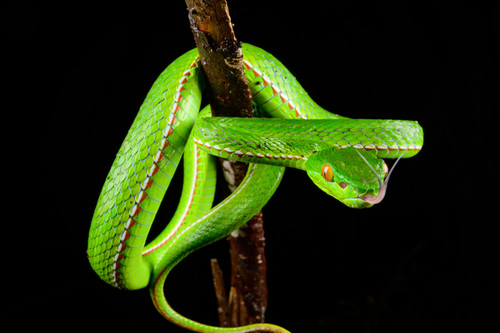
Stejneger's pit viper
The Chinese green tree viper (Trimeresurus stejnegeri) glides through Southeast Asia's lush canopies. With its striking emerald hue and heat-sensing pits, it expertly tracks prey. This arboreal predator plays a vital role in controlling small mammal populations, showcasing nature's balance within its forested realm.
Length: 76 cm
Size
Yellow, Green
Color
Medium
Aggression
Least Concern
Conservation Status
Stable
Population Trend
Characteristics
Trimeresurus stejnegeri, commonly known as the Chinese green tree viper, is a pit viper species found in Southeast Asia. It dwells in tropical and subtropical forests, exhibiting arboreal behavior. Known for its vibrant green coloration and heat-sensing pits, it preys on small mammals and birds.
Distribution Range of the Stejneger's pit viper
Trimeresurus stejnegeri, commonly known as the green pit viper or Stejneger's pit viper, is native to parts of East Asia. Its geographical distribution includes southern China, Taiwan, northern Vietnam, Laos, and parts of Myanmar and Thailand. It is primarily found in subtropical regions, often in hilly or mountainous areas.
Stejneger's pit viper's Habitat
Environmental Conditions
Trimeresurus stejnegeri typically inhabits subtropical and tropical forests, often preferring dense, moist environments. It is commonly found in evergreen forests, bamboo groves, and sometimes in secondary forests or near agricultural areas. The climate in these regions is generally humid, with significant rainfall and moderate to warm temperatures.
Ecological Niche
The green pit viper is an arboreal species, meaning it spends much of its time in trees or shrubs. It is well adapted to a life in the forest canopy, where it hunts for small mammals, birds, and other reptiles. Its green coloration provides excellent camouflage among leaves, aiding in both hunting and avoiding predators. This species is primarily nocturnal, being most active at night when it hunts and navigates its environment.
Copyright @ Nature Style Limited. All Rights Reserved.
 English
English